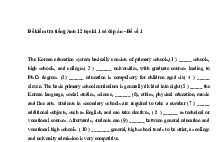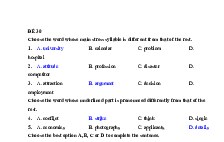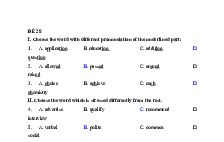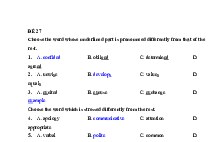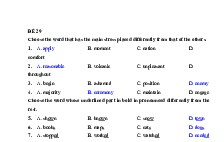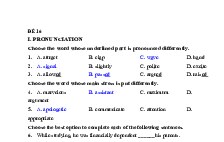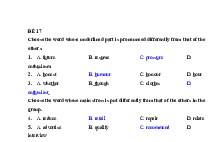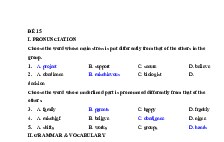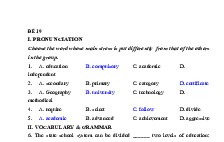23. Đề thi thử TN THPT 2021 - Môn Tiếng Anh - Bộ đề chuẩn cấu trúc minh họa - Đề 23 - File word có lời giải.
Nội dung tài liệu
Tải xuống
Link tài liệu:
Các tài liệu liên quan
-
![Đề thi học kì 1 Tiếng anh lớp 12 năm 2020-2021 ĐỀ SỐ 2]()
-
![Đề thi học kì 1 Tiếng anh lớp 12 năm 2020-2021 ĐỀ SỐ 1]()
-
![Đề thi học kì 1 Tiếng anh lớp 12 năm 2020-2021 ĐỀ SỐ 30]()
-
![Đề thi học kì 1 Tiếng anh lớp 12 năm 2020-2021 ĐỀ SỐ 28]()
-
![Đề thi học kì 1 Tiếng anh lớp 12 năm 2020-2021 ĐỀ SỐ 27]()
-
![Đề thi học kì 1 Tiếng anh lớp 12 năm 2020-2021 ĐỀ SỐ 29]()
-
![Đề thi học kì 1 Tiếng anh lớp 12 năm 2020-2021 ĐỀ SỐ 16]()
-
![Đề thi học kì 1 Tiếng anh lớp 12 năm 2020-2021 ĐỀ SỐ 17]()
-
![Đề thi học kì 1 Tiếng anh lớp 12 năm 2020-2021 ĐỀ SỐ 15]()
-
![Đề thi học kì 1 Tiếng anh lớp 12 năm 2020-2021 ĐỀ SỐ 14]()
Có thể bạn quan tâm
Thông tin tài liệu
ĐỀ CHUẨN MINH HỌA SỐ
23
KỲ THI TỐT NGHIỆP TRUNG HỌC PHỔ THÔNG NĂM 2021
(Đề thi có 05 trang)
Thời gian làm bài: 60 phút không kể thời gian phát đề
Bài thi: NGOẠI NGỮ; Môn thi: TIẾNG ANH
-------------------------Họ, tên thí sinh:…………………………………………………………………………
Số báo danh:....................................................................................................................
Mark the letter A, B, C, or D to indicate the word whose underlined part differs from the other three in
pronunciation in each of the following questions.
Question 1.
A. mended
B. faced
C. objected
D. waited
Question 2.
A. breakfast
B. featrure
C. peasant
D. pleasure
Mark the letter A, B, C, or D to indicate the word that differs from the other three in the position of
primary stress in each of the following questions.
Question 3.
A. suggest
B. suffer
C. impress
D. become
Question 4.
A. impression
B. improvement
C. family
D. pollutant
Mark the letter A, B, C, or D on your answer sheet to indicate the correct answer to each of the following
questions.
Question 5: The headmaster is the most popular figure at our school, ________?
A. isn’t he
B. was he
C. doesn’t he
D. did he
Question 6: This house is going ________ by my mother.
A. sold
B. to be sold
C. to sold
D. to sell
Question 7: Is there anything interesting ________ the newspaper today?
A. above
B. at
C. in
D. on
C. The harder
D. The hardest
Question 8: ________ he worked, the more he earned.
A. The more hard
B. The hard
Question 9: My aunt gave me a
hat on my 16th birthday.
A. nice yellow new cotton
B. new nice cotton yellow
C. new nice yellow cotton
D. nice new yellow cotton
Question 10: I saw Lisa at the museum when I ________ to restaurant.
A. was going
B. went
D. had gone
D. were going
Question 11: I didn’t get a job ________ I had all the necessary qualifications.
A. although
B. in spite of
C. because
D. because of
Question 12: I will have completed my first two years’ study at university ________.
A. by the time I finish the final term exams
B. after I had finished the final term exams
C. when I was finishing the final term exams
D. until I finished the final term exams
Question 13:
UNESCO criteria for outstanding universal value to humanity, Trang An Scenic
Landscape Complex was added to the World Heritage List in 2014.
A. Meeting
B. Met
C. To meet
Question 14: He has always been highly ________ in his work.
A. success
B. succeed
C. successful
D. Having met
D. successfully
Question 15: If you want to take part in volunteer organizations, you will have to ________ an application
form.
A. find out
B. fill in
Question 16: We have been working hard. Let’s
A. make
B. find
C. put on
D. look up
a break.
C. do
D. take
Question 17: Teachers’ _________ would rise an average of $1000 under the proposal.
A. pensions
B. salaries
C. wages
D. incomes
Question 18: I just couldn’t remember her name even though it was on the ______ of my tongue.
A. edge
B. tip
C. top
D. front
Question 19: The scientists are encountering the difficulties of _____ of radioactive waste.
A. depleting
B. preserving
C. eliminating
D. disposing
Mark the letter A, B, C, or Don your Answer sheet to Indicate the word(s) CLOSEST in meaning to the
underlined word(s) in each of the following questions.
Question 20: The use of lasers in surgery has become relatively commonplace in recent years.
A. absolutely
B. relevantly
C. comparatively
D. almost
Question 21: From the beginning, not so many people realized the danger of the Corona so they did not do
to protect themselves.
A. forgot
B. understood
C. questioned
D. suffered
Mark the letter A, B, C, or D on your answer sheet to Indicate the word(s) OPPOSITE in meaning to the
underlined word(s) In each of the following questions.
Question 22: Social psychologists have recently noticed strange behavior from people having suffered
from terrible shocks.
A. rare
B. common
C. negative
D. formal
Question 23: I didn’t tell her that he was sick because I didn’t want to cause her any alarm.
A. worry
B. inform
C. comfort
D. warn
Mark the letter A, 8, C, or D on your answer sheet to indicate the sentence that best completes each of
the following exchanges.
Question 24: Ben is talking to a school staff at the registration office.
Ben: “I would like to register for a class today.”
Staff: “________”
A. I hope that you are doing well with the course.
B. Well, what class would you like to take?
C. There are two classes that are still open.
D. Enjoy your life at the college, dear
Question 25: Thanh and Nadia have just listened to Lan’s song.
Thanh: “Lan’s the best singer in our school.”
Nadia: “______.I really love her beautiful voice.”
A. Yes, tell me about it!
B. I can’t agree with you more!
C. That’s OK!
D. Yes, please.
Read the following passage and mark the letter A, B, C or D on your answer sheet indicate the correct
word or phrase that best fits each of the numbered Weeks from 26 to 30
More and more routine, repetitive assembly tasks will be taken over by machines. But as certain
jobs disappear, new ones open up in (26) _____ parts of the factory. Germany in many ways exemplifies
this trend. Today, German manufacturers deploy three times more robots than U.S. companies, (27) ______
they also still employ more humans. Relative to the size of our economies, German’s manufacturing
workforce is twice the size of America’s.
From its very beginning, the fourth Industrial revolution has never (28) ________ manufacturers
with an either - or choice - robots or humans. It has always been about combining the talents of both.
Ultimately, it is the convergence of artificial and human intelligence (29) _____ will enable manufacturers
to achieve a new era of speed, flexibility, efficiency and connectivity in the 21st century. Machines have
the ability to assemble things faster than any human ever could, but humans possess the domain expertise
and (30) ______ knowledge required to solve problems and optimize factory floor production.
(Adapted from: http://time.com/4940374/joe-kaeser-siemens-robots-jobs/)
Question 26: A. another
B. other
C. every
D. one
Question 27: A. but
B. or
C. so
D. for
Question 28: A. finished
B. assembled
C. presented
D. deployed
Question 29: A. who
B. when
C. why
D. which
Question 30: A. valuable
B. artificial
C. potential
D. comparable
Read the following passage and mark the letter A. B, C, or D on your answer sheet to indicate the correct
answer to each of the questions from 31 to 35.
Nanotechnology is the creation and use of materials or devices at extremely small scales. These
materials or devices fall in the range of 1 to 100 nanometers (nm). One nm is equal to one-billionth of a
meter (.000000001 m), which is about 50,000 times smaller than the diameter of a human hair. Scientists
refer to the dimensional range of 1 to 100 nm as the nanoscale, and materials at this scale are called
nanocrystals or nanomaterials.
The nanoscale is unique because nothing solid can be made any smaller. It is also unique because many
of the mechanisms of the biological and physical world operate on length scales from 0.1 to 100 nm. At
these dimensions materials exhibit different physical properties; thus scientists expect that many novel
effects at the nanoscale will be discovered and used for breakthrough technologies.
A number of important breakthroughs have already occurred in nanotechnology. These developments
are found in products used throughout the world. Some examples are catalytic converters in automobiles
that help remove air pollutants, devices in computers that read from and write to the hard disk, certain
sunscreens and cosmetics that transparently block harmful radiation from the Sun, and special coatings for
sports clothes and gear that help improve the gear and possibly enhance the athlete’s performance. Still,
many scientists, engineers, and technologists believe they have only scratched the surface of
nanotechnology’s potential.
Nanotechnology is in its infancy, and no one can predict with accuracy what will result from the full
flowering of the field over the next several decades. Many scientists believe it can be said with confidence,
however, that nanotechnology will have a major impact on medicine and health care; energy production
and conservation; environmental cleanup and protection; electronics, computers, and sensors; and world
security and defense.
(Adapted from: Encarta DVD 2009)
Question 31: What is the passage mainly about?
A. A new physical property of matters in nature
B. A way of manufacturing technological products
C. An introduction to a new technology
D. An overview of how technology will develop
Question 32: The word “that” in paragraph 3 refers to ________ .
A. converters
B. automobiles
C. technologies
D. properties
Question 33: The word “novel” is closest in meaning to ________ .
A. causing a chemical reaction to happen faster
B. being different from anything known before
C. being important enough to be noticed
D. being the only one of its kind
Question 34: Which of the following statements is NOT true about nanotechnology according to the
passage?
A. No other products are smaller than those made by nanotechnology.
B. Nanotechnology allows the production of things at extremely small scales.
C. Nanotechnology has seen a number of important breakthroughs.
D. Medicine and healthcare will be greatly affected by nanotechnology.
Question 35: According to scientists, materials at the nanoscale are called ________.
A. nanocrystals or nanomaterials
B. nanotechnology’s potential
C. nanotechnology’s potential
D. catalytic converters
Read the following passage and mark the letter A, B, C or D on your answer sheet to indicate the correct
answer to each of the questions from 36 to 42
To quote CREST founder Dr. Martha Honey, we earnestly believe that ecotourism is “simply a better
way to travel.” Here’s a look at how this transformational approach to travel benefits conservation,
increases cross-cultural understanding, and ultimately turns travelers into environmental advocates:
To see how ecotourism benefits nature and wildlife, let’s look at endangered species such as African
Elephants. Ivory from Elephant tusks is worth $1500 a pound on the black market, which has led to a
dramatic increase in poaching. But Elephants are worth 76 times more alive than dead. When you consider
the revenue from wildlife photography tours, luxury safari camps, and other ecotourism offerings, a single
Elephant is worth $1.3 million over the course of its lifetime! Ecotourism offers a long-term alternative to
exploitation, generating sustainable revenue and ensuring better overall health of the ecosystem.
Nature reserves and national parks help prevent deforestation and pollution, while also protecting the
habitat of endemic species. The revenue that ecotourism provides can help replace profits from exploitative
practices such as mining or slash ‘n’ burn agriculture. It can also help ensure the long-term financial
viability of the area. Naturalist guides also help travelers understand the value of a pristine ecosystem, and
teach them about the importance of conservation. This ultimately help to create a more mindful and
conscious legion of travelers.
When managed properly, ecotourism can offer locals alternative revenue streams. In wildlife-rich
countries such as Rwanda, former poachers are often employed as guides or trackers, capitalizing on their
knowledge of the animals and their habitat. In Costa Rica, unemployment has fallen to less than 10% since
the country started building its ecotourism infrastructure in the 1970s. Involving local communities in
tourism management empowers them by ensuring that more revenue is reinvested locally. Ecotourism also
offers indigenous peoples an opportunity to remain on ancestral land, conserve it, and preserve traditional
culture.
Sure, being a responsible traveler takes a greater level of commitment to being conscious and mindful
of the impact we have on the destinations we visit. But ecotourism also offers us incredible, transformative
experiences, allowing us to develop closer personal relationships to the nature, wildlife, and local people
we encounter during our adventures. Learning about ecotourism can permanently change your
understanding of mankind’s role in our planetary ecosystem. And once you’ve had that sort of travel
experience, you’ll never want to travel the traditional way again.
(Adapted from: https://www.ith.org.za/what-is-eco-tourism/)
Question 36. The most suitable title for the passage could be ______.
A. The benefits of ecotourism.
B. Making the most of ecotourism.
C. An introduction to ecotourism.
D. Encourage conservation or adding to exploitation?
Question 37. The word “revenue” in paragraph 2 most likely means _______.
A. reward
B. benefit
C. profit
D. interest
Question 38. According to paragraph 3, in what direction can ethical tourism help the society?
A. Green tourism maintains the balance between animals and human.
B. Ecotourism provides financial support for local communities.
C. Sustainable tourism yields substantial environmental benefits.
D. Ecotourism encourages open dialogue about deforestation.
Question 39. The word “pristine” in paragraph 3 most likely means _______.
A. natural
B. untouched
C. beautiful
D. dirty
Question 40. The word “them” in paragraph 4 refers to _____.
A. species
B. relationships
C. poachers
D. locals
Question 41. According to paragraph 5, why did the author claim that people will prefer ecotourism over
normal one?
A. Because it is such an awakening and mind-expanding experience.
B. Because the author is a trend-setting writer who believes in his words’ influence.
C. Because anything with a green label on it is all the craze now.
D. Because the standard of ecotourism service is more satisfying than other types.
Question 42. Which of the following statements is TRUE, according to the passage?
A. Momentary profits are more recommended than long-term ones.
B. Indigenous inhabitants are forced to resettle to develop sites for tourism.
C. Income from ecotourism can partly be substituted for environmentally harmful industry.
D. People engage in green tourism only for their self-image.
Mark the letter A, B, C, or D on your answer sheet to indicate the underlined part that needs correction
in each of the following questions.
Question 43: The man, a poor man, is invited to the Clambake last night.
A
B
C
D
Question 44: Some manufacturers are not only raising their prices but also decreasing the production of its
A
B
C
D
products.
Question 45. Jessie looked so frightened when she was in that white costume with long black hair.
A
B
C
D
Mark the letter A, B, C, or D on your answer sheet to indicate the sentence that is closest in meaning to
each of the following questions.
Question 46: This is the first time we have been to the circus.
A. We have been to the circus some times before.
B. We had been to the circus once before.
C. We have ever been to the circus often before.
D. We have never been to the circus before.
Question 47: "I’ll take the children to the park," said the husband to his wife.
A. The husband asked the wife to take the children to the park.
B. The husband offered to take the children to the park.
C. The husband insisted on taking the children to the park.
D. The husband requested to take the children to the park.
Question 48: It isn’t necessary for you to finish the report by Sunday.
A. You don’t have to finish the report by Sunday.
B. You might finish the report by Sunday.
C. You must finish the report by Sunday.
D. You can’t finish the report by Sunday.
Mark the letter A, B, C, or D on your answer sheet to indicate the sentence that best combines each pair
of sentences in the following questions.
Question 49: Nam was so rude to them last night. Now he feels regretful.
A. Nam regrets to have been so rude to them last night.
B. Nam regrets having so rude to them last night.
C. Nam wishes he hadn’t been so rude to them last night.
D. Nam wishes he weren’t so rude to them last night.
Question 50: Olga was about to say something about the end of the movie. He was stopped by his friends
right then.
A. Hardly had Olga intended to say something about the end of the movie when he was stopped by
his friends.
B. Only after Olga had said something about the end of the movie was he stopped by his friends.
C. Not until Olga was about to say something about the end of the movie was he stopped by his
friends.
D. It was not until Olga was stopped by his friends that he started to say something about the end of
the movie.
--------------- HẾT ---------------
MA TRẬN
Mức độ nhận thức
Câu
Đơn vị kiến thức
Nhận biết
1
Phát âm
1
2
Phát âm
1
3
Trọng âm
1
4
Trọng âm
1
5
Câu hỏi đuôi
1
6
Câu bị động
7
Giới từ
8
So sánh kép
2
9
Trật tự tính từ
1
10
Thì của động từ
11
Liên từ
1
12
Mệnh đề trạng ngữ
1
13
Phân từ hoàn thành
14
Từ loại
1
15
Phrasal verb
1
16
Từ vựng
1
17
Từ vựng
1
18
Thành ngữ
1
19
Cụm từ cố định
20.
Từ đồng nghĩa
21.
Từ đồng nghĩa
1
22.
Từ trái nghĩa
1
23.
Từ trái nghĩa
24.
Giao tiếp
1
25.
Giao tiếp
1
26.
Đọc điền từ
1
27.
Đọc điền từ
1
28.
Đọc điền từ
1
29.
Đọc điền từ
1
30.
Đọc điền từ
31.
Đọc ý chính văn bản
32.
Đọc thông tin chi tiết
1
33.
Đọc tìm từ đồng nghĩa
1
Thông hiểu
Vận dụng
Vận dụng
cao
1
1
1
1
1
1
1
1
1
34.
Câu tham chiếu
1
35.
Thông tin chi tiết
1
36.
Ý chính văn bản
1
37.
Từ đồng nghĩa
1
38.
Thông tin chi tiết
1
39.
Từ đồng nghĩa
1
40.
Câu tham chiếu
41.
Thông tin cụ thể
42.
Suy luận
43.
Tìm lỗi sai
44.
Tìm lỗi sai
45.
Tìm lỗi sai
46.
Biến đổi câu đơn
1
47.
Biến đổi câu đơn
1
48.
Biến đổi câu đơn
1
49.
Biến đổi câu ghép
1
50.
Biến đổi câu ghép
1
1
1
1
1
1
1
ĐÁP ÁN
1. B
2. A
3. B
4. C
5. A
6. B
7. C
8. C
9. D
10. A
11. A
12. A
13. D
14. C
15. B
16. D
17. B
18. D
19. B
20. C
21. B
22. B
23. C
24. B
25. B
26. B
27. A
28. C
29. D
30 A
31. C
32. A
33. B
34. A
35. A
36. A
37. C
38. C
39.B
40. D
41. A
42. C
43. C
44. D
45. A
46. D
47. B
48. A
49. C
50. A
LỜI GIẢI CHI TIẾT
Question
Key
Explanation
1.
b
2.
A
Kiến thức về phát âm đuôi “ed”
Cách phát âm đuôi “ed”:
+ Đuôi “ed” được phát âm là /t/ khi động từ có phát âm kết thúc là /tʃ/, /θ/, /ʃ/, /s/,
/k/, /p/, /f/
+ Đuôi “ed” được phát âm là /ɪd/ khi động từ có phát âm kết thúc là /t/, /d/
+ Đuôi “ed” được phát âm là /d/ với các trường hợp còn lại
A. mend /mendɪd/
B. faced / -feɪst/
C. objected/ˈɒb.dʒɪktɪd/
D. waited /weɪtɪd/
Phương án B phần gạch chân phát âm là /t /, còn lại phát âm là / ɪd /
Kiến thức về phát âm nguyên âm:
A. breakfast /ˈbrek.fəst/
B. wife /waɪf/
3.
B
4.
C
5.
A
6.
C
7.
C
8.
C
9.
D
10.
A
11.
A
C. nine /naɪn/
D. shift /ʃɪft/
Kiến thức về trọng âm của từ có 2 âm tiết:
- Âm /ə/ và /ɪ/ là các âm thường không nhận trọng âm
A. suggest /səˈdʒest/
B. suffer /ˈsʌfə(r)/
C. impress /ɪmˈpres/
D. become /bɪˈkʌm/
Kiến thức về trọng âm của từ có 3 âm tiết:
A. impression /ɪmˈpreʃn/
B. improvement /ɪmˈpruːvmənt/
C. family /ˈfæməli/
D. pollutant /pəˈluːtənt/
Kiến thức về câu hỏi đuôi:
- Phần đầu ở thể khẳng định => Phần đuôi ở thể phủ định
- Động từ ở phần đầu: is => phần đuôi : isn’t
Kiến thức câu bị động của thì tương lai gần:
S + am/is/are + going to + be + Vp2
Đáp án; to be sold
Kiến thức về giới từ:
- in the newspaper: trên báo
Kiến thức về so sánh lũy tiến:
The + tính từ so sánh hơn + S + V, the + tính từ so sánh hơn + S + V
Dạng so sánh hơn của tính từ “hard” là “harder” . Đáp án: the harder
Kiến thức về trật tự của tính từ:
Khi có nhiều tính từ cùng đứng trước 1 danh từ, sắp xếp chúng theo thứ tự:
OSASCOMP + N. Trong đó:
O- opinion: quan điểm
S – size: kích thước
A – age: độ tuổi (mới, cũ, trẻ, già,...)
S – shape: hình dạng
C – color: màu sắc
O – origin: nguồn gốc
M – material: chất liệu
P - purpose: mục đích
N – noun: danh từ
=> Trật tự tính từ:”nice” chỉ nhận xét, quan điểm + “new” – chỉ độ tuổi +
“yellow” – chỉ màu sắc, + “cotton” – chỉ chất liệu.
Kiến thức về thì của động từ:
Thì quá khứ đơn và quá khứ tiếp diễn kết hợp trong câu: Diễn tả hành động đang
xảy ra trong quá khứ thì một hành động khác xen vào, hành động đang xảy ra chi
thì quá khứ tiếp diễn, hành động xen vào chia thì quá khứ đơn
Cấu trúc: S + was/ were + V_ing + when + S + Ved/bqt
Đáp án: was going
Kiến thức về liên từ:
Because + clause (S + V): bởi vì
Athough + clause (S + V), clause (S + V): mặc dù
Because of + Cụm danh từ/ V-ing: bởi vì
In spite of + Cụm danh từ/ V-ing: mặc dù, bất chấp
- Ở câu này “I had all the necessary qualification” là mệnh đề, vì vậy loại
đáp án B và D.
Tạm dịch: Tôi không tìm được việc mặc dù tôi có đầy đủ các bằng cấp
cần thiết.
Chọn: A. although
Kiến thức về mệnh đề chỉ thời gian:
- Key word: will have completed
Đáp án: by the time + thì hiện tại đơn
Kiến thức: Mệnh đề phân tử / Rút gọn mệnh đề đồng ngữ
Giải thích:
Khi 2 mệnh đề có cùng chủ ngữ (she) thì có thể rút gọn 1 trong 2 mệnh đề về
dạng:
- V-ing / Having P2: nếu mệnh đề được rút gọn mang nghĩa chủ động
- P2 (quá khứ phân từ): nếu mệnh đề được rút gọn mang nghĩa bị động
Đáp án: Having met
Kiến thức về dạng của từ:
- be + trạng từ + tính từ. has always been highly + Adj
A. success (n)
B. succeed (v)
C. successful (adj)
D. successfully (adv)
-
12.
A
13.
D
14.
C
15.
B
16.
D
17.
B
18.
D
19.
B
20.
C
21.
B
Kiến thức về cụm động từ:
- A. find out: tìm ra
B. fill in: điền vào (đơn)
C. put on: mặc
D. look up: tra cứu
- Dịch câu: Nếu bạn muốn tham gia các tổ chức tình nguyện, ban sẽ phải điền
vào đơn đăng ký.
Kiến thức về cụm từ cố định:
- Take a break: Nghỉ giải lao
Kiến thức về từ vựng
A. Pension /ˈpen.ʃən/ (n): tiền trợ cấp lương hưu
B. Salary /ˈsæl.ər.i/ (n): tiền lương cơ bản(theo năm)
C. Wage /weɪdʒ/ (n): tiền lương (theo tháng, theo ngày công)
D. Income /ˈɪn.kʌm/ (n): thu nhập
Tạm dịch: Lương của giáo viên sẽ tăng trung bình 1000 đô theo sự đề xuất.
Kiến thức về từ vựng:
- A. depleting : làm cạn kiệt
B. preserving: bảo tồn
C. eliminating: xoá bỏ
D. disposing: loại bỏ (+ of)
Kiến thức về thành ngữ:
- on the tip of one’s tongue: biết nhưng không thể nhớ ra
Kiến thức về từ cùng nghĩa:
relatively: tương đối = comparatively
A. absolutely: hoàn toàn
B. relevantly: có liên quan
D. almost: gần như, hầu như
Kiến thức về từ cùng nghĩa:
realized: nhận ra = understood
A. forgot: quên
C. question: đặt câu hỏi
D. suffer: chịu đưng
22.
B
23.
C
24.
B
25.
B
26.
27.
A
A
28.
C
29.
D
30.
A
31.
C
Kiến thức về từ trái nghĩa:
strange: kì lạ >< common: bình thường
A. rare: quí hiếm
C. negative: tiêu cực
D. formal: trang trọng
Kiến thức về từ trái nghĩa:
Cause her any alarm: làm kinh động ai
A. worry: làm lo lắng
B. inform: thông báo
C. comfort: dỗ dành, an ủi
D. warn: cảnh báo
Kiến thức về câu giao tiếp thông thường
Tạm dịch
Ben: Tôi muốn đăng ký một lớp học ngày hôm nay.
Nhân viên: Bạn muốn đăng ký lớp học nào?
Câu giao tiếp bày tỏ ý kiến
I can’t agree with you more: đây là hình thức đưa ra quan điểm tán thành với ý
kiến của người trước
Other + N plural
Today, German manufacturers deploy three times more robots than U.S.
companies, (27) ______ they also still employ more humans.
Tạm dịch
Ngày nay, các nhà máy ở Đức sử dụng robot nhiều gấp ba lần các công ty Mỹ,
nhưng học vẫn thuê thêm nhân công.
presented: đưa ra - phù hợp với ý nghĩa của câu này
Tạm dịch: Ngay từ khi bắt đầu, cuộc cách mạng công nghiệp lần thứ tư đã không
bao giờ đưa ra cho các nhà sản xuất một lựa chọn hoặc - robot hoặc con người.
Nó luôn luôn là về sự kết hợp tài năng của cả hai.
Intelligence(n): trí thông minh
Chọn đáp án D. which (đi sau danh từ chỉ sự vật, sự việc, hiện tượng)
Machines have the ability to assemble things faster than any human ever could,
but humans possess the domain expertise and (30) ______ knowledge required to
solve problems and optimize factory floor production.
A. valuable: có ích, quan trọng, quí giá
B. artificial: nhân tạo
C. potential: tiềm năng
D. comparable: có thể so sánh được
Chọn đáp án A. valuable knowledge: kiến thức quan trọng
Tạm dịch: Máy móc có khả năng lắp ráp mọi thứ nhanh hơn bất kỳ người nào,
nhưng con người có chuyên môn và kiến thức quan trọng để giải quyết các vấn
đề và đánh giá 1 cách lạc quan việc sản xuất.
Tạm dịch: Đoạn văn chủ yếu nói về điều gì?
A. Một tính chất vật lý mới của các chất trong tự nhiên.
B. Một cách để sản xuất ra các sản phẩm công nghệ.
C. Sự giới thiệu về một công nghệ mới.
D. Tổng quan về cách mà công nghệ sẽ phát triển.
Dựa vào câu đầu tiên của đoạn văn: Công nghệ nano là sự tạo ra và sử dụng các
vật liệu hoặc các thiết bị ở kích thước đặc biệt nhỏ. Và những câu văn giới thiệu
về công nghệ này như: kích thước cụ thể của vật liệu nano (dòng 2 – đoạn 1: in
the range of 1 to 100 nanometers), công nghệ này đang trong giai đoạn sơ khai
(dòng đầu – đoạn cuối: in its infancy).
=>Đáp án C
32.
A
33.
B
34.
A
35.
A
36.
A
37.
C
Từ “that” trong đoạn 2 ám chỉ ________.
*Với dạng Câu hỏi này, hãy đọc Câu ngay trước, hoặc ngay trong câu chứa nó
để suy luận từ được quy chiếu.
“Some examples are catalytic converters in automobiles that help remove air
pollutants…” Một vài ví dụ như là bộ chuyển đổi xúc tác trong ô tô thứ mà giúp
loại bỏ đi khí thải…
=>”that” ở đây chính là bộ chuyển đổi xúc tác (catalytic converters / converters)
Từ “novel” gần nghĩa nhất với _______.
Dựa vào vị trí của từ trong đoạn văn, từ “novel” ở đây là một tính từ.
“At these dimensions materials exhibit different physical properties; thus
scientists expect that many novel effects at the nanoscale will be discovered and
used for breakthrough technologies.”
Tạm dịch: Ở kích thước này, vật liệu thể hiện các tính chất vật lý khác thường; vì
vậy các nhà khoa học mong đợi rằng nhiều hiệu ứng “novel” ở cấp độ nano sẽ
được khám phá ra và được sự dụng cho các công nghệ mang tính đột phá.
“novel”: mới, khác với những gì đã từng được biết
=>đáp án B
Theo đoạn văn, nhận định nào sau đây là KHÔNG đúng về công nghệ nano?
A. Không sản phầm nào nhỏ hơn những sản phầm làm ra bằng công nghệ nano.
B. Công nghệ nano cho phép sản xuất ra những vật ở cấp độ cực kỳ nhỏ.
C. Công nghệ nano đã tạo ra rất nhiều bước đột phá quan trọng.
D. Y học và lĩnh vực chăm sóc sức khỏe sẽ nhận được những tác động lớn từ
công nghệ nano.
Phương án A (tìm hiểu câu 1 – đoạn 2): “nothing solid can be made any
smaller”: không một vật gì bằng chất rắn có thể làm nhỏ hơn được nữa.
Phương án B: (đoạn 1): công nghệ nano là tạo ra và sử dụng các vật liệu ở cấp độ
vô cùng nhỏ.
Phương án C (câu 1 – đoạn 4): Rất nhiều bước đột phá quan trọng đã được tạo ra
trong công nghệ nano.
Phương án D ( câu 2 – đoạn 4): Rất nhiều nhà khoa học tin tưởng chắc chắn
rằng: công nghệ nano sẽ có ảnh hưởng lớn tới y học và sự chăm sóc sức khỏe.
=>đáp án A
Theo các nhà khoa học, các vật liệu ở cấp độ nano được gọi là _______.
Thông tin ở câu cuối – đoạn 1: ..and materials at this scale are called
nanocrystals or nanomaterials.
=>đáp án A
‘
Tiêu đề phù hợp nhất cho đoạn văn có thể là ___.
A. Lợi ích của du lịch sinh thái.
B. Tận dụng tối đa du lịch sinh thái.
C. Giới thiệu về du lịch sinh thái.
D. Khuyến khích bảo tồn hoặc thêm vào việc khai thác?
Căn cứ vào thông tin đoạn đầu:
To quote CREST founder Dr. Martha Honey, we earnestly believe that
ecotourism is "simply a better way to travel." Here's a look at how this
transformational approach to travel benefits conservation, increases crosscultural understanding, and ultimately turns travelers into environmental
advocates (Trích dẫn người sáng lập CREST, Tiến sĩ Martha Honey, chúng tôi
rất tin tưởng rằng du lịch sinh thái là "một cách đơn giản hơn để đi du lịch”. Đây
là một cái nhìn về cách tiếp cận chuyển đổi để mang lại lợi ích du lịch bảo tồn,
tăng hiểu biết đa văn hóa và cuối cùng biến du khách thành người ủng hộ môi
trường.)
Như vậy, đoạn văn đang nói về lợi ích của việc du lịch sinh thái.
Từ "revenue" trong đoạn 2 có thể có nghĩa gần nhất với .
38.
C
39.
B
40.
D
41.
A
A. phần thưởng
B. lợi ích
C. lợi nhuận
D. lãi
Từ đồng nghĩa revenue (doanh thu) = profit
When you consider the revenue from wildlife photography tours, luxury safari
camps, and other ecotourism offerings, a single Elephant is worth $1.3 million
over the course of its lifetime! (Khi bạn xem xét doanh thu từ các tour chụp ảnh
động vật hoang dã, trại đi săn sang trọng và các dịch vụ du lịch sinh thái khác,
một con Voi trị giá 1,3 triệu đô la trong vòng đời của nó!)
Theo đoạn 3, du lịch đạo đức có thể giúp ích gì cho xã hội theo hướng nào?
A. Du lịch xanh duy trì sự cân bằng giữa động vật và con người.
B. Du lịch sinh thái cung cấp hỗ trợ tài chính cho cộng đồng địa phương.
C. Du lịch bền vững mang lại lợi ích đáng kể về môi trường.
D. Du lịch sinh thái khuyến khích đối thoại cởi mở về nạn phá rừng.
Căn cứ vào thông tin đoạn ba:
Nature reserves and national parks help prevent deforestation and pollution,
while also protecting the habitat of endemic species. The revenue that ecotourism
provides can help replace profits from exploitative practices such as mining or
slash burn agriculture. (Khu bảo tồn thiên nhiên và vườn quốc gia giúp ngăn
chặn nạn phá rừng và ô nhiễm, đồng thời bảo vệ môi trường sống của các loài
đặc hữu. Doanh thu mà du lịch sinh thái cung cấp có thể giúp thay thế lợi nhuận
từ các hoạt động khai thác mỏ hoặc đốt nương làm rẫy.)
Từ "pristine" trong đoạn 3 có thể có nghĩa gần nhất với .
A. tự nhiên
B. hoang sơ
C. đẹp
D. dơ bẩn
Từ đồng nghĩa pristine (nguyên sinh) =untouched
Naturalist guides also help travelers understand the value of a pristine ecosystem,
and teach them about the importance of conservation. (Hướng dẫn tự nhiên cũng
giúp khách du lịch hiểu giá trị của một hệ sinh thái nguyên sinh và dạy họ về tầm
quan trọng của việc bảo tồn.)
Từ "them” trong đoạn 4 đề cập đến .
A. loài
B. mối quan hệ
C. kẻ săn trộm
D. người địa phương
Từ “them” ở đây dùng để thay thế cho danh từ người dân địa phương trước đó.
Involving local communities in tourism management empowers them by
ensuring that more revenue is reinvested locally. (Tham gia cộng đồng địa
phương trong việc quản lý du lịch trao quyền cho họ bằng cách đảm bảo rằng
nhiều doanh thu được tái đầu tư tại địa phương.)
Theo đoạn 5, tại sao tác giả tuyên bố rằng mọi người sẽ thích du lịch sinh thái
hơn du lịch truyền thống?
A. Bởi vì đó là một trải nghiệm thức tỉnh và mở rộng hiểu biết.
B. Bởi vì tác giả là một nhà văn thiết lập xu hướng, người tin vào ảnh hưởng của
lời nói của chính mình.
C. Bởi vì bất cứ điều gì với một nhãn màu xanh lá cây trên đó là các cơn sốt lúc
bây giờ.
D. Vì tiêu chuẩn của dịch vụ du lịch sinh thái thỏa mãn hơn các loại khác.
Căn cứ vào thông tin đoạn năm:
Sure, being a responsible traveler takes a greater level of commitment to being
conscious and mindful of the impact we have on the destinations we visit. (Chắc
42.
C
43.
C
44.
D
45.
A
46.
D
47.
B
48.
A
49.
C
50.
A
chắn, là một du khách có trách nhiệm cần một mức độ cam kết cao hơn để có ý
thức và lưu tâm đến tác động của chúng ta đến các điểm đến chúng ta ghé thăm.)
Learning about ecotourism can permanently change your understanding of
mankind’s role in our planetary ecosystem. (Học về du lịch sinh thái có thể thay
đổi vĩnh viễn sự hiểu biết của bạn về vai trò của loài người trong hành tinh của
chúng ta hệ sinh thái.)
Phát biểu nào sau đây là đúng, theo đoạn văn?
A. Lợi nhuận tạm thời được khuyến nghị nhiều hơn so với lợi nhuận dài hạn.
B. Cư dân bản địa buộc phải tái định cư để phát triển các địa điểm du lịch.
C. Thu nhập từ du lịch sinh thái một phần có thể được thay thế cho ngành công
nghiệp gây hại môi trường.
D. Mọi người tham gia vào du lịch xanh chỉ vì hình ảnh bản thân của họ.
Căn cứ vào thông tin đoạn ba:
The revenue that ecotourism provides can help replace profits from exploitative
practices such as mining or slash burn agriculture. It can also help ensure the
long-term financial viability of the area. (Doanh thu mà du lịch sinh thái cung
cấp có thể giúp thay thế lợi nhuận từ các hoạt động khai thác mỏ hoặc đốt nương
làm rẫy. Nó cũng có thể giúp đảm bảo khả năng tài chính lâu dài của khu vực.)
Kiến thức: Thì của động từ
Last night => thì quá khứ đơn: is => was
Kiến thức: Sử dụng đúng tính từ sở hữu
Manufacturers nên phair dùng tính từ sở hữu their
Từ gây nhầm lẫn về nghĩa
- frightened: miêu tả cảm giác Jessie cảm thấy sợ hãi
- frightening: miêu tả cảm giác Jessie làm cho người khác cảm thấy sợ hãi
Tạm dịch câu: Jessie trông đáng sợ khi mặc bộ đồ trắng toát với mái tóc đen dài
ấy.
Biến đổi câu giữa thì quá khứ đơn và thì hiện tại hoàn thành.
It / This is the first time + S + V (HTHT-KĐ) +…………
↔ S + V(HTHT-PĐ)+ ………… +before
Câu đề bài: This is the first time we have been to the circus.
=>We have never been to the circus before.
Kiến thức: Câu tường thuật
Giải thích:
Câu trực tiếp ở thì tương lai đơn, diễn tả một đề xuất
=> Câu tường thuật dùng động từ tường thuật “offer”
Cấu trúc: S + offered + to V....: Ai đó đã hứa làm gì
Động từ khuyết thiếu
It isn’t neccessary for sb to V = S + don’t/ doesn’t have to: diễn tả sự không cần
thiết phải làm gì
Kiến thức: Câu ước ở quá khứ
Giải thích:
Dấu hiệu: “last night” – “hôm qua”
Cấu trúc câu ước với “wish” ở quá khứ: S + wish + S + had Vp2: Điều ước
không có thật ở quá khứ
Đề bài: Nam was so rude to them last night. Now he feels regretful.
=>C. Nam wishes he hadn’t been so rude to them last night.
Đảo ngữ
Tạm dịch:
Olga chuẩn bị nói 1 vài điều về kết thúc của bộ phim. Ngay sau đó, bạn anh ta
ngăn anh ta lại.
A. Ngay khi Olga có ý định nói 1 vài điều về kết thúc của bộ phim thì bạn anh ta
ngăn lại.



